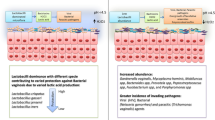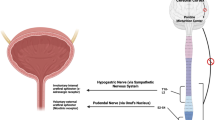Abstract
Purpose
The objective of this study is to quantify and evaluate the expression of several important proteins in TGF-β1/Smad pathway in the anterior vaginal wall in postpartum rats with stress urinary incontinence (SUI).
Methods
Forty 8-week-old Sprague–Dawley (SD) female rats were randomized into three groups: blank group (n = 10), control group (n = 10) and SUI group (n = 20). Rats in blank group were non-pregnant, while rats in the control and SUI groups underwent normal parturition and normal parturition plus immediate postpartum vaginal balloon dilation, respectively. 1 week after dilation, a sneezing experiment and pad test were performed and the anterior vaginal wall was collected. The histological changes of the anterior vaginal wall were assessed by hematoxylin–eosin (HE) staining, and the expression of TβR-2, Smad3 and Smad7 in the anterior vaginal wall was detected by immunohistochemical staining and Western blotting.
Results
HE staining showed that collagen was more fragmented, sparse and disorganized in the SUI group compared with the control and blank groups. Compared with the blank group, the expression of TβR-2 and Smad7 protein was significantly increased in the vaginal anterior wall in the control and SUI groups (P < 0.05), while their levels in the SUI group were significantly higher than those in the control group (P < 0.05). Expression of Smad3 protein in the anterior vaginal wall of SUI rats was significantly decreased compared with the blank and control groups (P < 0.05).
Conclusion
Dysregulation of the TGF-β1/Smad signaling pathway may involve in the pathogenesis of SUI.



Similar content being viewed by others
Abbreviations
- SUI:
-
Stress urinary incontinence
- IHC:
-
Immunohistochemistry
- ECM:
-
Extracellular matrix
- TGF-β1:
-
Transforming growth factor-β1
- TβR-2:
-
Transforming growth factor receptor II
References
Chan SS, Cheung RY, Yiu KW, Lee LL, Chung TK (2013) Prevalence of urinary and fecal incontinence in Chinese women during and after their first pregnancy. Int Urogynecol J 24(9):1473–1479. doi:10.1007/s00192-012-2004-8
Findik RB, Unluer AN, Sahin E, Bozkurt OF, Karakaya J, Unsal A (2012) Urinary incontinence in women and its relation with pregnancy, mode of delivery, connective tissue disease and other factors. Adv Clin Exp Med 21(2):207–213
Song Y, Hong X, Yu Y, Lin Y (2007) Changes of collagen type III and decorin in paraurethral connective tissue from women with stress urinary incontinence and prolapse. Int Urogynecol J Pelvic Floor Dysfunct 18(12):1459–1463. doi:10.1007/s00192-007-0356-2
Trabucco E, Soderberg M, Cobellis L, Torella M, Bystrom B, Ekman-Ordeberg G, Petraglia F, Colacurci N (2007) Role of proteoglycans in the organization of periurethral connective tissue in women with stress urinary incontinence. Maturitas 58(4):395–405. doi:10.1016/j.maturitas.2007.09.010
Nakao A, Imamura T, Souchelnytskyi S, Kawabata M, Ishisaki A, Oeda E, Tamaki K, Hanai J, Heldin CH, Miyazono K, ten Dijke P (1997) TGF-beta receptor-mediated signalling through Smad2, Smad3 and Smad4. EMBO J 16(17):5353–5362. doi:10.1093/emboj/16.17.5353
Heldin CH, Miyazono K, ten Dijke P (1997) TGF-beta signalling from cell membrane to nucleus through SMAD proteins. Nature 390(6659):465–471. doi:10.1038/37284
Nakao A, Afrakhte M, Moren A, Nakayama T, Christian JL, Heuchel R, Itoh S, Kawabata M, Heldin NE, Heldin CH, ten Dijke P (1997) Identification of Smad7, a TGFbeta-inducible antagonist of TGF-beta signalling. Nature 389(6651):631–635. doi:10.1038/39369
Cutroneo KR, White SL, Phan SH, Ehrlich HP (2007) Therapies for bleomycin induced lung fibrosis through regulation of TGF-beta1 induced collagen gene expression. J Cell Physiol 211(3):585–589. doi:10.1002/jcp.20972
Jimenez SA, Varga J, Olsen A, Li L, Diaz A, Herhal J, Koch J (1994) Functional analysis of human alpha 1(I) procollagen gene promoter. Differential activity in collagen-producing and -nonproducing cells and response to transforming growth factor beta 1. J Biol Chem 269(17):12684–12691
Chen SJ, Yuan W, Mori Y, Levenson A, Trojanowska M, Varga J (1999) Stimulation of type I collagen transcription in human skin fibroblasts by TGF-beta: involvement of Smad 3. J Invest Dermatol 112(1):49–57. doi:10.1046/j.1523-1747.1999.00477.x
Poncelet AC, Schnaper HW (2001) Sp1 and Smad proteins cooperate to mediate transforming growth factor-beta 1-induced alpha 2(I) collagen expression in human glomerular mesangial cells. J Biol Chem 276(10):6983–6992. doi:10.1074/jbc.M006442200
Li GY, Cui WS, Zhou F, Gao ZZ, Xin H, Liu T, Li WR, Gong YQ, Bai GY, Guo YL, Xin ZC (2012) Pathology of urethral fibromuscular system related to parturition-induced stress urinary incontinence and TGF-beta1/Smad pathway. Mol Cell Biochem 364(1–2):329–335. doi:10.1007/s11010-012-1234-x
Qiang F, Guo-long L (2011) Comparative study of three rat models of stress urinary incontinence. Bosn J Basic Med Sci 11(2):87–90
Heidkamp MC, Leong FC, Brubaker L, Russell B (1998) Pudendal denervation affects the structure and function of the striated, urethral sphincter in female rats. Int Urogynecol J Pelvic Floor Dysfunct 9(2):88–93
Pauwels E, De Wachter S, Wyndaele JJ (2009) Evaluation of different techniques to create chronic urinary incontinence in the rat. BJU Int 103(6):782–785. doi:10.1111/j.1464-410X.2008.08158.x (discussion 785–786)
Liebergall-Wischnitzer M, Paltiel O, Hochner-Celnikier D, Lavy Y, Shveiky D, Manor O (2010) Concordance between one-hour pad test and subjective assessment of stress incontinence. Urology 76(6):1364–1368. doi:10.1016/j.urology.2010.05.048
Hochstim CJ, Choi JY, Lowe D, Masood R, Rice DH (2010) Biofilm detection with hematoxylin–eosin staining. Arch Otolaryngol Head Neck Surg 136(5):453–456. doi:10.1001/archoto.2010.62
Goepel C, Thomssen C (2006) Changes in the extracellular matrix in periurethral tissue of women with stress urinary incontinence. Acta Histochem 108(6):441–445. doi:10.1016/j.acthis.2006.07.001
Chen B, Yeh J (2011) Alterations in connective tissue metabolism in stress incontinence and prolapse. J Urol 186(5):1768–1772. doi:10.1016/j.juro.2011.06.054
Goepel C, Hefler L, Methfessel HD, Koelbl H (2003) Periurethral connective tissue status of postmenopausal women with genital prolapse with and without stress incontinence. Acta Obstet Gynecol Scand 82(7):659–664
Edwall L, Carlstrom K, Jonasson AF (2005) Markers of collagen synthesis and degradation in urogenital tissue from women with and without stress urinary incontinence. Neurourol Urodyn 24(4):319–324. doi:10.1002/nau.20142
Wen Y, Polan ML, Chen B (2006) Do extracellular matrix protein expressions change with cyclic reproductive hormones in pelvic connective tissue from women with stress urinary incontinence? Hum Reprod 21(5):1266–1273. doi:10.1093/humrep/dei485
Wen Y, Zhao YY, Polan ML, Chen B (2008) Effect of relaxin on TGF-beta1 expression in cultured vaginal fibroblasts from women with stress urinary incontinence. Reprod Sci 15(3):312–320. doi:10.1177/1933719108315299
Zandvoort A, Postma DS, Jonker MR, Noordhoek JA, Vos JT, van der Geld YM, Timens W (2006) Altered expression of the Smad signalling pathway: implications for COPD pathogenesis. Eur Respir J 28(3):533–541. doi:10.1183/09031936.06.00078405
Medina C, Santos-Martinez MJ, Santana A, Paz-Cabrera MC, Johnston MJ, Mourelle M, Salas A, Guarner F (2011) Transforming growth factor-beta type 1 receptor (ALK5) and Smad proteins mediate TIMP-1 and collagen synthesis in experimental intestinal fibrosis. J Pathol 224(4):461–472. doi:10.1002/path.2870
Moro T, Shimoyama Y, Kushida M, Hong YY, Nakao S, Higashiyama R, Sugioka Y, Inoue H, Okazaki I, Inagaki Y (2008) Glycyrrhizin and its metabolite inhibit Smad3-mediated type I collagen gene transcription and suppress experimental murine liver fibrosis. Life Sci 83(15–16):531–539. doi:10.1016/j.lfs.2008.07.023
Chiang TA, Yang YL, Yang YY, Hu MH, Wu PF, Liu SF, Huang RM, Liao TN, Hung CY, Hung TJ, Lee TC (2010) Hyperosmolarity enhanced susceptibility to renal tubular fibrosis by modulating catabolism of type I transforming growth factor-beta receptors. J Cell Biochem 109(4):663–671. doi:10.1002/jcb.22444
Phanish MK, Wahab NA, Colville-Nash P, Hendry BM, Dockrell ME (2006) The differential role of Smad2 and Smad3 in the regulation of pro-fibrotic TGFbeta1 responses in human proximal-tubule epithelial cells. Biochem J 393(Pt 2):601–607. doi:10.1042/bj20051106
Yang F, Chung AC, Huang XR, Lan HY (2009) Angiotensin II induces connective tissue growth factor and collagen I expression via transforming growth factor-beta-dependent and -independent Smad pathways: the role of Smad3. Hypertension 54(4):877–884. doi:10.1161/hypertensionaha.109.136531
Acknowledgments
This study was supported by a Grant from the Science Technology and Information Bureau of Guangzhou (Grant No. 201300000137) and a fund for Excellent Talents in the Third Affiliated Hospital of Guangzhou Medical University.
Conflict of interest
We declare that we have no conflict of interest. We state that we have had full control of all primary data and we agree to allow the Journal to review our data if requested.
Author information
Authors and Affiliations
Corresponding author
Rights and permissions
About this article
Cite this article
Wang, H., Liu, J., Zeng, J. et al. Expression of TβR-2, Smad3 and Smad7 in the vaginal anterior wall of postpartum rats with stress urinary incontinence. Arch Gynecol Obstet 291, 869–876 (2015). https://doi.org/10.1007/s00404-014-3495-y
Received:
Accepted:
Published:
Issue Date:
DOI: https://doi.org/10.1007/s00404-014-3495-y




